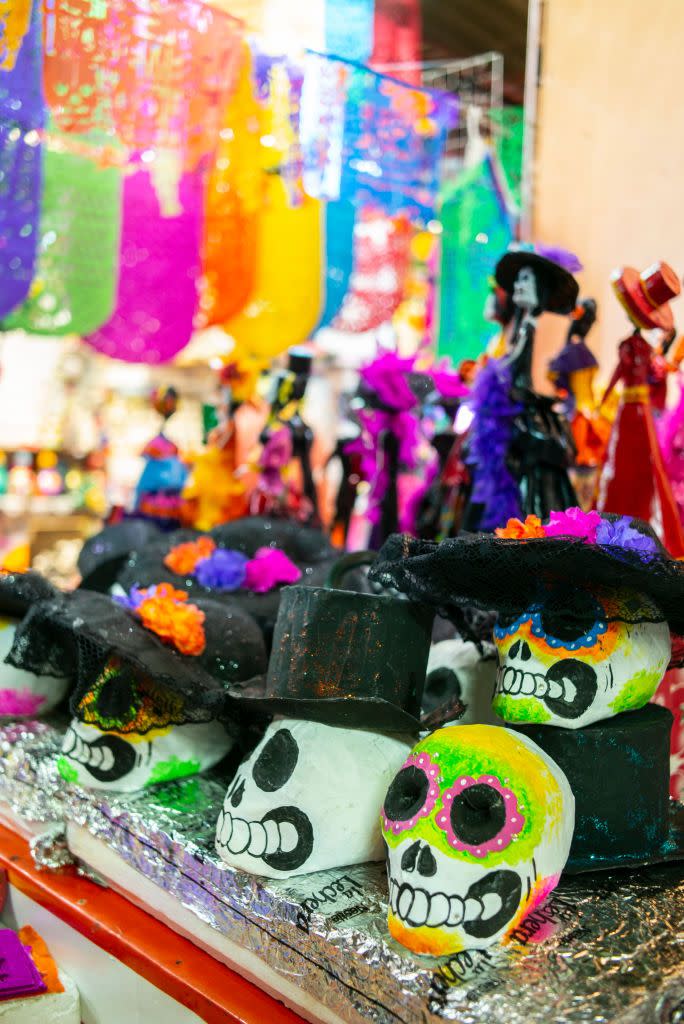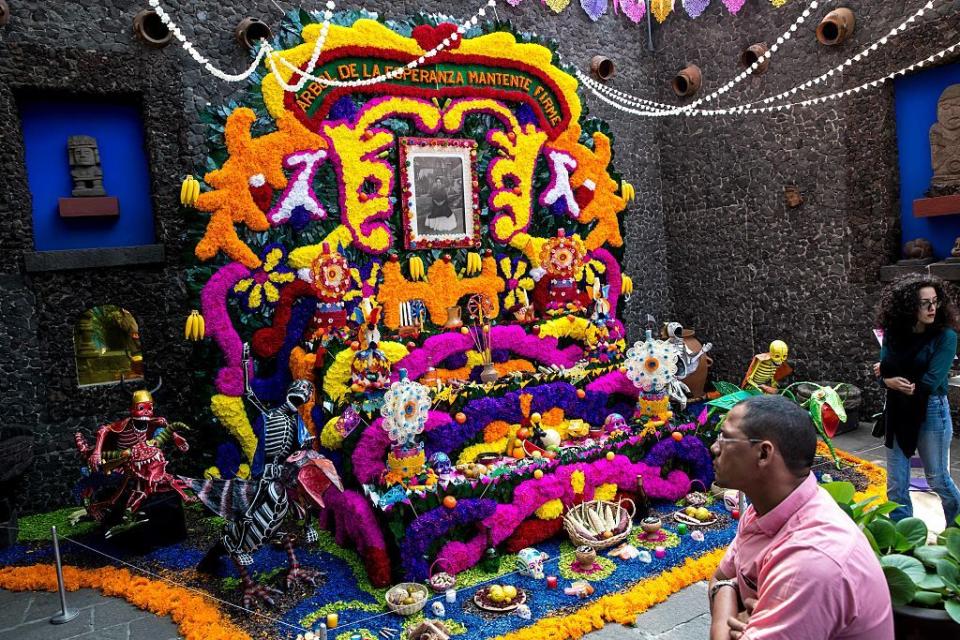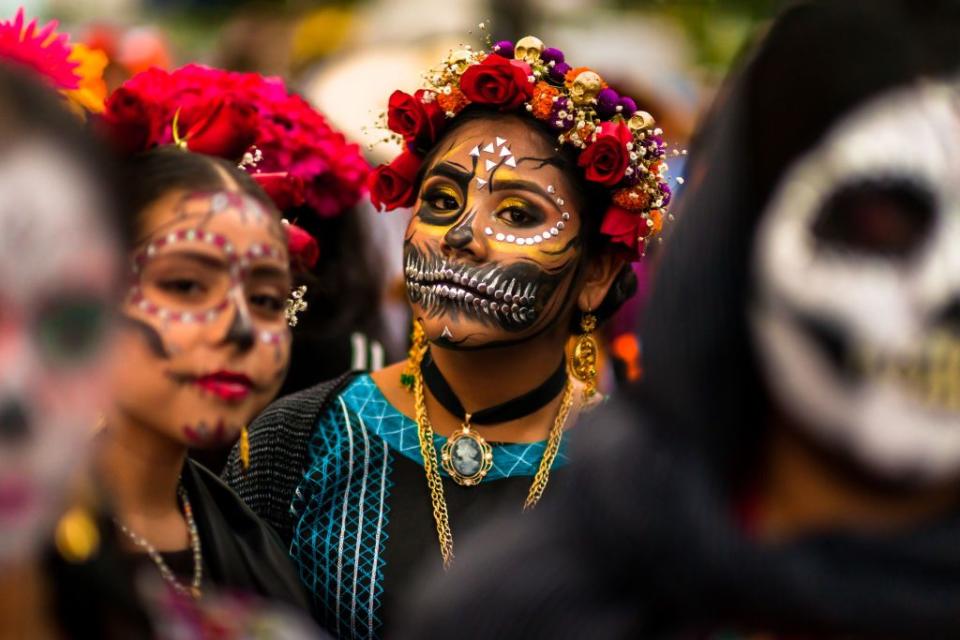What to Know About the Vibrant Traditions of Día de los Muertos
"Hearst Magazines and Yahoo may earn commission or revenue on some items through the links below."
Day of the Dead—or Día de los Muertos—celebrates life.
With spirited traditions that largely take place across Mexico, Latin America, and the United States, family and friends come together to honor their lost loved ones on November 1 and 2. Traditions include gathering at cemeteries to enjoy traditional foods like pan de muerto (bread of the dead) and calaveras (sugar skulls), dressing up in eye-catching costumes, and assembling colorful floral decorations, which often include symbolic marigolds.
"This tradition is rooted in the native Mexican belief that life on earth is a preparation for the next world and of the importance of maintaining a strong relationship with the dead," Juan Aguirre, Executive Director of the Mexican culture non-profit Mano a Mano tells Oprah Daily.
But what is at the heart of these beloved festivities? Here's a look at the Day of the Dead's rich history, and some facts you might not have known about the Mexican holiday.
"It’s not a funeral. It’s not morbid, and it’s not about being spooky. It’s about joy and color and flavor and celebration, all the mixed emotions," James Beard Award-winning chef Pati Jinich adds."It’s a very Mexican thing to have extreme sadness with extreme joy at the same time."
Here's a look at the Day of the Dead's rich history, and some facts you might not have known about the Mexican holiday.
Día de los Muertos is not a somber occasion.
During the ancient Mexican holiday, it's believed that spirits of the dead momentarily return to the land of the living, for a brief reunion. The community looks at death as an opportunity for renewed life.
Day of the Dead is celebrated with parades, festivals, and more across Mexico.

Though these traditions are universal, various regions across the country also have their own unique takes on how to honor the dead. Mexico City has held a boisterous parade since 2016, complete with entertainers in bold costume, music and dance, and floats. National Geographic identifies Michoacán as the place to go for foodies. The people of La Huasteca Potosina indulge in day-long parties, while Aguascalientes' festival of skulls have near week-long celebrations that include their annual skeleton parade, Legends of Mexico. And at Guanajuato's University of Guanajuato, students create an altar (much-loved by photo-snapping tourists) that honors deceased scholars.
Día de los Muertos is not connected to Halloween.
While Halloween and Day of the Dead occur nearly in tandem and share similar customs (candy, face painting, and community gathering), the two are not related. Halloween has ancient Celtic roots, while Day of the Dead has its own origins that date back to the Indigenous people of Mexico and Central America.

The holiday first began with the Aztecs.
Roughly 3000 years ago, amongst the Aztec, Toltec, and Mayans, death and the dead were seen as a natural part of life that should be honored and celebrated, rather than mourned. In particular, the Nahua people of central Mexico believed the deceased traveled on a years-long journey to Chicunamictlán, the Land of the Dead. The living would provide supplies, such food and water, to aid them on the trek. This practice inspired the modern tradition of creating altars—known as ofrendas—at their homes, in addition to leaving offerings at the gravesites of loved ones.
Día de los Muertos wasn't always celebrated in November.
Once the Spanish colonized Mexico in the 16th century, their own Catholic views on the dead influenced Mexican customs. Día de los Muertos was originally celebrated in the summer months. The holiday came to fall on November 1 and November 2 to align with All Saints Day and All Souls Day on the Catholic calendar. The first day honors children who have passed, while the second celebrates adults.
Want more stories to inspire you to live your best life? Sign up to become an Oprah Insider!
Altars, or ofrendas, are the centerpiece of celebrations.

To beckon spirits back into the Land of the Living for the festivities, revelers create makeshift altars, or ofrendas, at their homes and at the gravesites of their deceased loved ones. Families gather at the site to eat, tell stories, and even clean the graves.
Offerings to the dead are inspired by the four elements.
Ofrendas are decorated with offerings for the spirits that are meant to represent the four elements: fire, water, earth, and wind.
Ofrendas are decorated with offerings for the spirits that are meant to represent the four elements: fire, water, earth, and wind.
Fire: Candles are lit to help guide the spirits' journey.
Water: Pitchers of water are left to quench their thirst while traveling to the Land of the Living.
Earth: A variety of traditional foods are prepared to help nourish the dead.
Wind: Papel picado are vibrant delicate paper banners are strung. They're decorated with elaborate cut-out patterns, that are said to allow souls to pass through.
Altars are also adorned with sentimental photographs, toys, marigolds, and skulls.
Traditional Mexican foods play a huge part in celebrations.

As mentioned, when gathering offerings for the ofrendas, the earth element is an integral part of preparations. And since that symbolizes the food eaten throughout the holiday, it's basically its own category.
Pan de Muerto translates to "bread of the dead."
The most prominent food consumed is pan de muerto, or bread of the dead, which is a yeast-based sweet egg bread. Other delicacies include calabaza en tacha (candied pumpkin), calaveras (the famous sugar skulls), tamales, atole, and spicy Mexican hot chocolate.
One of the most prominent symbols of the holiday—the signature skull face—originated from a Mexican illustrator.

It's likely that even those who don't celebrate Day of the Dead are familiar with the holiday's famous symbol: calaveras, aka, the skull. Perhaps you've seen them as decorative face paint, costumes, delicious sugary treats, or even in Pixar's Oscar-winning animated film, Coco. But as with everything for Dia de los Muertos, its significance has a rich history.
Around 1910, Mexican illustrator Jose Guadalupe Posada created a satirical lithograph that offered commentary on the political and societal unrest at the time; particularly the elite's tendency to adopt Eurocentric customs. According to The Grace Museum, the image—a skeleton donning a decorative European-style hat—depicted Chicunamictlan, the queen of the Aztec underworld. Posada dubbed her La Catrina, which is a slang word for "the rich." La Calavera Catrina means elegant skull.

Years later, in 1947, famed artist Diego Rivera depicted an elaborately dressed La Catrina in his celebrated mural Dream of a Sunday Afternoon. As it is displayed in Mexico City's Alameda Park, La Catrina gained even more visibility amongst the country's people. As a leader of the dead, and an integral part of Aztec history, she was a natural fit amongst Day of the Dead celebrations.
Cempasúchiles, or marigolds, bring color to the festivities.

While cempasúchiles are often used as an offering to decorate ofrendas, over time they've earned a spot next to skulls as one of the most prominent Day of the Dead symbols. Also known as flor de muerto, or flowers of the dead, the importance of the lively orange and yellow marigolds date back to the time of the Aztecs, according to Remezcla. The color and scent of the flowers are believed to lure spirits from their places of rest to their families.
If you want to wear a Day of the Dead costume, consider this.
"Sugar skull makeup," as it's called in many a Youtube beauty tutorial, is undeniably gorgeous on a purely aesthetic level; it's a large part of why it's been a popular Halloween costume idea for years. Know that if you're not of Latino or Hispanic—and of Mexican descent, particularly—some people may consider this cultural appropriation.
If you do decide to wear sugar skull makeup and other costume accoutrements such as flower crown headbands and traditional Mexican dresses, there are ways to make sure you're doing so respectfully. Keep in mind that, again, Day of the Dead is actually unrelated to Halloween. Before you apply that face paint, take a moment to educate yourself on the historical and lasting cultural significance of La Catrina. And, as Refinery29 notes, avoid any bloody or scary elements to your costume, because uplifting celebration is an integral part of Día de los Muertos.
You Might Also Like

